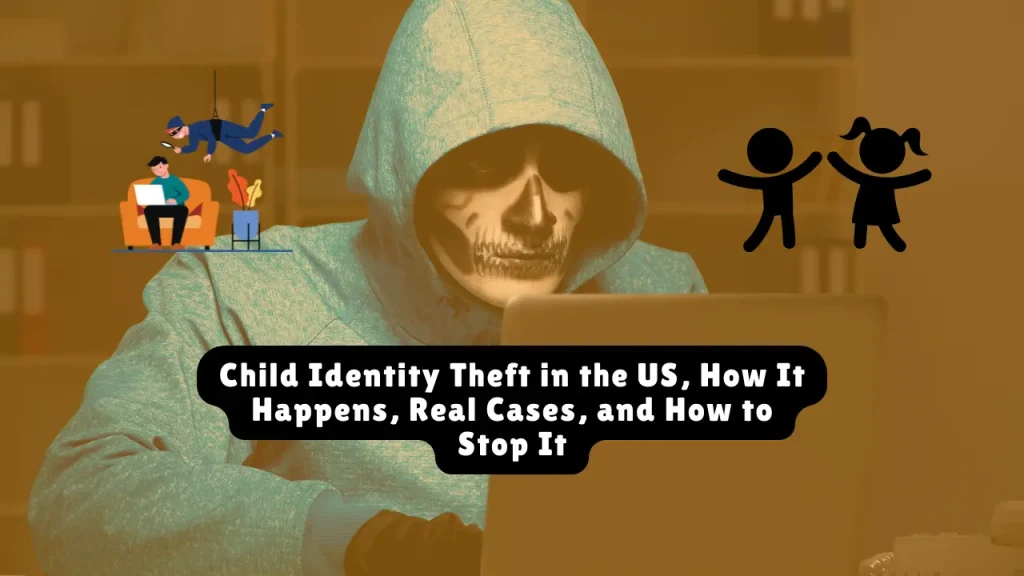Child Identity Theft in the US, How It Happens, Real Cases, and How to Stop It
Child identity theft is a growing but often overlooked threat in the United States. According to Javelin Strategy & Research, 1.25 million children fell victim in 2020 alone—half of them under age 9. Even more alarming, children are 51 times more likely to experience identity theft than adults. This silent epidemic costs American families over $1.1 billion annually and can go unnoticed for years, damaging credit histories and delaying future milestones like college, car loans, and home rentals.
This article explains how child identity theft occurs, presents real-life examples, outlines red flags to watch for, and offers expert-approved prevention and recovery strategies.
Table of Contents
What Is Child Identity Theft and Why Are Kids Targeted?
Unlike adult identity theft, which often involves immediate financial gain, child identity theft typically exploits the child’s unused credit profile. Since children usually don’t apply for credit, fraud using their Social Security number (SSN) can go undetected for years—until they turn 18 or apply for their first loan, credit card, or job.
Criminals use children’s identities to:
- Open credit cards or loans
- File false tax returns
- Claim government benefits (e.g., Medicaid, child tax credits)
- Commit medical fraud
- Launder money through “synthetic identities”
Also read: How To Find Out If Someone Is Using My Child’s Social Security Number?
How Child Identity Theft Happens
1. Family Members or Trusted Adults (75% of Cases)
Most perpetrators are close to the child—parents, stepparents, relatives, or family friends. They often have easy access to documents and may misuse them during financial stress.
Case in Point: Axton Betz-Hamilton, an identity-theft researcher, discovered at age 19 that her mother had stolen her identity for over a decade. She was denied an apartment due to fraudulent credit card debt racked up in her name.
2. Data Breaches and School/Medical System Hacks
Children’s data is vulnerable in underfunded schools and healthcare systems.
- In 2023, a ransomware attack on Minneapolis Public Schools exposed 200,000 students’ SSNs, later sold on the dark web.
- From 2022 to 2023, school-related data breaches more than doubled from 45 to 108.
3. Synthetic Identity Theft
Fraudsters create fake profiles using a child’s SSN mixed with false names and birthdates—called synthetic identities. These are used to slowly build credit before executing major financial fraud. The Federal Reserve considers synthetic ID theft the fastest-growing form of fraud, disproportionately affecting minors.
4. Physical Document Theft
Unsecured documents like SSN cards or birth certificates are stolen from mailboxes, homes, or offices.
Example: A retiree’s home was ransacked, and the thief used his late wife’s SSN to commit years of fraud.
5. Phishing & Online Exploits
Children on social platforms like TikTok, Instagram, Roblox, and Fortnite are vulnerable to phishing. Fraudsters pose as game friends or contest hosts to solicit personal information.
6. “Sharenting” Risks
Well-meaning parents sharing baby photos, school events, or medical updates online may expose key identifiers (birth dates, full names, locations) that can be scraped by data brokers or fraudsters.
Related article: Employment Identity Theft, How It Happens, Who It Hurts, and How to Fight Back

What Criminals Do With a Stolen Child Identity
- Open fraudulent credit card accounts
- Buy or lease cars and apartments
- File fake tax returns or apply for child tax credits
- Get medical treatment under the child’s name
- Apply for unemployment benefits and government programs
Warning Signs Your Child’s Identity May Be Compromised
- Debt collection calls or bills addressed to your child
- IRS or SSA notices about income or benefits in your child’s name
- Pre-approved credit card offers
- Your child is denied government benefits because they’re “already claimed”
- AnnualCreditReport.com shows an existing credit file for your child
- Dark web alerts from monitoring services
Related article: How to Tell If Someone Is Using Your Social Security Number (SSN )
Immediate Response If Your Child Is a Victim
- Report the Fraud
- Visit IdentityTheft.gov to file an official Identity Theft Report and create a Recovery Plan.
- File a police report with supporting documents (sample letters available via California DOJ or other AG sites).
- Visit IdentityTheft.gov to file an official Identity Theft Report and create a Recovery Plan.
- Contact the Social Security Administration
- Verify the use of your child’s SSN and request a new one if compromised.
- Verify the use of your child’s SSN and request a new one if compromised.
- Freeze Your Child’s Credit
- Contact all three bureaus (Equifax, Experian, TransUnion) to freeze the child’s credit. You’ll need to submit:
- The child’s birth certificate
- SSN
- Your government-issued ID
- The child’s birth certificate
- Contact all three bureaus (Equifax, Experian, TransUnion) to freeze the child’s credit. You’ll need to submit:
- This freeze prevents any new accounts from being opened and is free for minors under the Fair Credit Reporting Act (FCRA).
- Dispute Unauthorized Accounts
- Send dispute letters with supporting documentation to each credit bureau to remove the fraudulent entries.
Proven Ways to Prevent Child Identity Theft
1. Freeze Their Credit at Birth
Submit the child’s documents to all three credit bureaus as soon as they’re issued a Social Security number.
2. Store Documents Safely
Keep SSN cards, passports, and birth certificates in fireproof safes. Shred all paperwork containing personal information before disposal.
3. Limit Digital Exposure
- Tighten privacy settings on social media.
- Avoid public posts that include full names, birthdates, school names, or location tags.
- Use private groups or encrypted apps for family updates.
4. Use Identity Monitoring Services
Services like Aura, LifeLock, Experian Child & Family, or IdentityIQ offer:
- Dark web scanning
- Credit file monitoring
- Up to $1 million in identity theft insurance
5. Educate Older Children
Teach them how to spot phishing, use secure passwords, and avoid oversharing online.
Long-Term Monitoring & Recovery
- Annual Credit Checks as your child nears 18 or applies for student loans or jobs.
- After removing a freeze, consolidate credit files and dispute leftover errors.
- Work with nonprofits like the Identity Theft Resource Center (ITRC) for free recovery help, legal referrals, and hotline support.
Legal Protections & Resources
- FCRA & FACTA: Provide rights for minors to dispute accounts, request freezes, and obtain extended fraud alerts.
- State AG Support:
- California DOJ: Child Identity Theft Guide
- Florida DOA: Step-by-step guides and freeze templates
- Georgia AG: Parental resources and statistics
- California DOJ: Child Identity Theft Guide
Community & School Involvement
- School District Partnerships: Teach digital citizenship and privacy protection.
- Sharenting Awareness: Encourage mindful posting through campaigns by child-safety nonprofits.
- Local Workshops: Host identity protection events at libraries and community centers.
Conclusion: Take Action Before It’s Too Late
Child identity theft is stealthy, devastating, and preventable. With synthetic fraud and data breaches on the rise, parents must take proactive steps:
- Freeze credit at birth
- Secure and limit exposure of personal information
- Monitor accounts and the dark web
- Educate children about online safety
Schools and communities should integrate identity protection into education. By acting early and staying vigilant, families can protect their children’s futures from invisible but lasting harm.
Helpful Links
- IdentityTheft.gov – Recovery Plan & Report Tool
- AnnualCreditReport.com – Free Credit Report Access
- Experian – Child Identity Protection
- ITRC – Identity Theft Resource Center
About the Author

Sarah Klein, JD, is a former consumer rights attorney who spent years helping clients with issues like unfair billing, product disputes, and debt collection practices. At All About Lawyer, she simplifies consumer protection laws so readers can defend their rights and resolve problems with confidence.
Read more about Sarah
